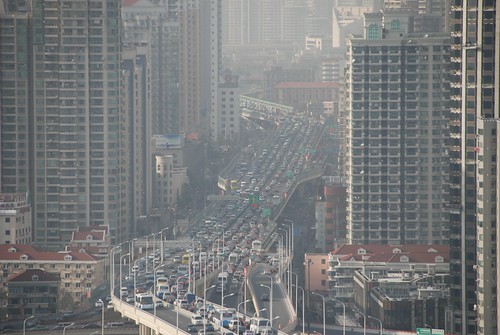全球市長發布利馬公報 城市溫室氣體排放擬新規
Category: 水新聞 Created: Thursday, 11 December 2014 03:498日祕魯利馬氣候峰會上,發表了全球第一個城市溫室氣體排放標準「全球社區協議-溫室氣體排放規模目錄」(GPC),幫助城市計算溫室氣體排放,建立完整的排放核算和公報管理系統。
全球7成溫室氣體出自城市 應有專屬碳排標準
在9月的紐約聯合國長氣候峰會上,氣候團體向各國市長和氣候行動專家強調,城市是氣候問題的最大來源,因為超過半數的全球人口住在都會區,城市製造了全球70%的能源相關溫室氣體。
WRI成員Ryan Schleeter和Wee Kean Fong更指出,現在開發中城市的排放已經趕上已開發城市,「北京、上海、天津等中國城市人均排放已經接近歐美大都市。都會區的環境衝擊仍在持續成長,因為接下來20年,城市人口還會增加140億,並吸引數兆元的投資。」
GPC由華盛頓智庫世界資源研究所(World Resources Institute,WRI)、C40城市減碳聯盟(C40 Cities Climate Leadership Group)和地方政府永續發展理事會(ICLEI – Local Governments for Sustainability)耗時3年所完成。
運用GPC,城市可以發展出排放基線、設定減緩目標、發展氣候行動計畫和定期追蹤成效。
採GPC減碳新規 全球上百位市長簽署利馬公報
巴西里約熱內盧是GPC測試版實驗的35個城市之一。
2011年,里約熱內盧市長Eduardo Paes制定了一項深具企圖心的氣候變遷法,欲在2020年減少20%排放。不過當時,里約官員並不知道里約熱內盧的溫室氣體排放量,也不知道排放來源。官員導入GPC後,計算出交通佔了總排放的39%,垃圾佔了19%。他們發現針對這兩個領域減排,就能達成20%的目標。
使用GPC的城市數量至此增加到超過100個,未來可望繼續增加。
8日的利馬氣候峰會,全世界大小城市的市長再次承諾,身為地方政府,將合作發展氣候行動,減少溫室氣體排放。與會市長並聯合發表「利馬公報」,成為聯合國氣候變化框架公約第20屆締約方大會(COP20)的談判產出之一。
紐約聯合國秘書長氣候高峰會上組成的「市長聯盟」,是全世界最主要的城市對抗氣候變遷聯盟,將採用GPC設定氣候目標並在平台上報告執行進度。所有報告的數據將由市長聯盟指定的「全球城市碳申報與登錄平台」(Carbon Climate Registry)整合和公佈。
The first global standard to measure greenhouse gas emissions from cities was launched Monday in tandem with the ongoing UN climate summit in Lima.
The Global Protocol for Community-Scale Greenhouse Gas Emissions Inventories (GPC) is the first internationally accepted standard for measuring emissions at the city level, enabling cities to establish credible emissions accounting and reporting practices.
Using the GPC, cities can develop an emissions baseline, set mitigation goals, create more targeted climate action plans and track their progress over time.
The GPC was developed over the past three years by the Washington, DC-based think-tank World Resources Institute (WRI), the C40 Cities Climate Leadership Group, and ICLEI – Local Governments for Sustainability.
Cities are the largest source of the problem, they told the biggest gathering of mayors and climate action experts since the UN Secretary-General’s Climate Summit in September in New York, because half the global population lives in urban areas, and cities produce 70 percent of the world’s energy-related CO2 emissions.
Even now, emerging cities are catching up to developed cities in their emissions, said Fong and Schleeter. “The Chinese cities of Beijing, Shanghai, and Tianjin, for example, have per capita emissions similar to those of large European and North American cities. And the environmental impact of urban areas is poised to grow – cities are expected to gain 1.4 billion people in the next 20 years and attract trillions of dollars’ worth of investments.”
At their meeting Monday in Lima’s historic municipal hall, the mayors of the world’s major cities, and many smaller cities as well, cemented the commitment of local governments to step up collaborative climate action and scale down greenhouse gas emissions.
They produced the Lima Communiqué, which will feed into the ongoing negotiations across town at COP20, the 20th Conference of the governments that are Parties to the UN Framework Convention on Climate Change.
There, delegates from more than 190 countries are negotiating the draft text of a new universal legally-binding climate change agreement to limit greenhouse gas emissions, to be adopted a year from now in Paris.
Rio de Janeiro, Brazil is one of the 35 cities that pilot-tested a beta version of the Global Protocol.
In 2011, Rio de Janeiro Mayor Eduardo Paes enacted an ambitious climate change law, setting a goal to avoid 20 percent of its emissions by 2020. But at the time, Rio officials had no idea how much the city was emitting, or where its emissions were coming from.
By using the new GPC protocol, city officials calculated that transport produced 39 percent of its emissions and waste produced 19 percent. They found that targeting emissions reductions in these sectors would help Rio meet its 20 percent target.
The number of cities using the GPC has since risen to more than 100 and is expected to grow in the near future.
Under the Compact of Mayors, the world’s largest effort for cities to fight climate change, debuted at the UN Secretary-General’s Climate Summit in September, cities will set climate targets and report against these targets into a reporting platform, using the newly-launched GPC.
All reported data will be consolidated and made publicly available through the Carbon Climate Registry, the Compact’s designated central repository.
※ 全文及圖片詳見:ENS
Read more http://e-info.org.tw/node/103914









